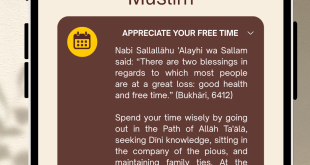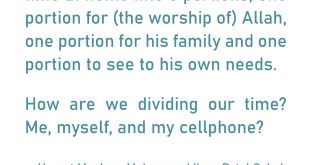
Adherence to the Sunnah of Performing Salaah with Jamaat in the Musjid
Hazrat Moulana Khaleel Ahmad Sahaaranpuri (rahimahullah) was a great Muhaddith, Faqeeh and saint of his time. He was the Sheikh (spiritual mentor) of Hazrat Moulana Muhammad Ilyaas Kaandhelwi (rahimahullah), the founder of the Tableegh Jamaat effort, as well as Hazrat Sheikhul Hadith, Moulana Muhammad Zakariyya (rahimahullah), the author of the two famous books of Hadith, Fazaa’il-e-A’maal and Fazaa’il-e-Sadaqaat.
Mufti Aashiq Ilaahi Meerati (rahimahullah) writes the following incident regarding Hazrat Moulana Sahaaranpuri (rahimahullah) and his firm commitment to attending the congregational salaah in the Musjid:
“At all times, salaah with jamaat in the musjid would be the source of pleasure and joy for Hazrat Moulana Khaleel Ahmad Saheb (rahimahullah). Hence, one can well imagine the extent of his joy when it came to salaah in the Haram Shareef.
“It would be impossible for any one of Hazrat’s (rahimahullah) associates to declare that he had witnessed Hazrat (rahimahullah) either missing the takbeer-e-ula, missing the first saff or not standing on the right of the imaam. Despite the heat being so intense that by merely placing one’s foot on the ground, blisters would begin to appear, Hazrat (rahimahullah) would hurriedly walk to the Haram Shareef so that he may perform his salaah in the first saff near the imaam.
“I clearly remember that on one occasion, we experienced torrential rain after the Maghrib Salaah. On seeing the heavy downpour, some of our companions began saying that the concession in the Hadith “ألا صلوا في رحالكم” (Perform your salaah at home i.e. due to the severe rain) could now be practised. However, no sooner did the sound of the azaan fall on Hazrat’s (rahimahullah) ears, he immediately turned to me and said, “Come, let us go for salaah.”
“Despite my spirits being low at that time, I mustered the courage to accompany Hazrat (rahimahullah) to the Haram Shareef. I took a lantern with me while Hazrat (rahimahullah) took a container of water. This confused me, as Hazrat (rahimahullah) had already performed wudhu. Hazrat (rahimahullah) then explained, “It is possible that our feet will become soiled with mud while walking to the Haram Shareef. Hence, we shall use this water to wash our feet at the entrance of the Haram Shareef so that we do not soil the Haram Shareef.”
“Prior to this, I had not witnessed or even seen the state of Makkah Mukarramah with rain and mud. As we stepped onto the road, it seemed as if the ground was gripping our feet (due to the mud). With each step, I wished that Hazrat (rahimahullah) would turn back and practise on the concession.
“I fully understood that walking in this condition was difficult for Hazrat (rahimahullah), yet he was still walking ahead of me. Each one of us had an umbrella in one hand while I held the lantern in the other hand and Hazrat (rahimahullah) had the container of water in his other hand. We walked to the end of the bazaar until we reached the road. Thereafter, we only needed to cross the road in order to reach the Haram Shareef.
“As we arrived at the road, we found that it was covered by a stream of water that was 25 – 30 feet wide and was flowing very strongly. I became afraid of crossing the stream and was convinced that Hazrat (rahimahullah) would now decide to turn back.
“Contrary to my expectation, Hazrat (rahimahullah) said, “Fold the umbrellas and pull up your trousers (to your knees). Take off your shoes, place them under your arms and we shall hold each other’s hands and step into the water. I have heard that these streams carry a lot of stones and there is a fear of falling.”
“That wonderful spectacle is still before my eyes – walking barefoot with our trousers folded to our knees, holding each other’s hands like a pair of scissors and with the umbrellas hanging on our arms. Hazrat (rahimahullah) then recited, “Bismillaahi majrehaa” and placed his foot into the fast-flowing stream.
“Since the water was flowing downstream and the path was steep, it carried along all sizes of stones and pebbles. They were flowing with such force that it was as if one was being struck with bullets. As we walked further, the water began to reach my knees and I was on the verge of falling. However, Hazrat (rahimahullah) quickly held my arms firmly and saved me from falling.
“With firm reliance on Allah Ta‘ala, we finally reached Baabus-Safaa. As we climbed the steps, Hazrat (rahimahullah) rinsed his feet, placed his shoes in the rack and then entered the Haram Shareef reciting the masnoon dua.” (Tazkiratul Khaleel pg. 370-371)
The Importance Hazrat Moulana Sahaaranpuri (rahimahullah) Showed to the Takbeer-e-Ula
Hazrat Moulana Zafar Ahmad Uthmaani (rahimahullah) relates the following incident:
“I remained for six years in the khidmat (service) of Hazrat Moulana Khaleel Ahmad Sahaaranpuri (rahimahullah). During this period, I never witnessed Hazrat (rahimahullah) missing his takbeer-e-ula. However, there was one occasion when Hazrat’s (rahimahullah) mouth began to bleed continuously while making wudhu for Fajr Salaah.
“Hazrat (rahimahullah) then sent a message to the musjid with one of his attendants instructing that the jamaat should not be delayed for his sake. This was the only time that I had witnessed Hazrat (rahimahullah) missing the takbeer-e-ula, though he completed the wudhu and managed to get the first rakaat.” (Tazkiratul Khaleel pg. 345)
From the above two incidents, it is clear that our pious predecessors showed extreme importance to performing salaah with jamaat in the musjid. They were prepared to undergo any difficulty or inconvenience, but they were not prepared to forego their salaah with jamaat in the musjid. May Allah Ta‘ala bless us all with the towfeeq to perform our five daily salaah with jamaat in the musjid.
Source:Ihyaauddeen
 Wifāq ul Ulāma (SA) ASSOCIATION OF SOUTH AFRICAN 'ULAMA
Wifāq ul Ulāma (SA) ASSOCIATION OF SOUTH AFRICAN 'ULAMA

